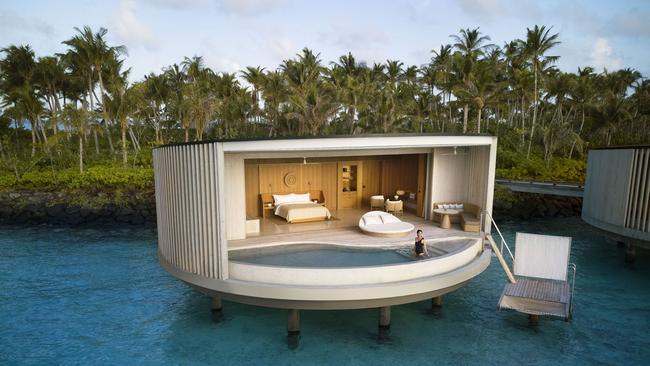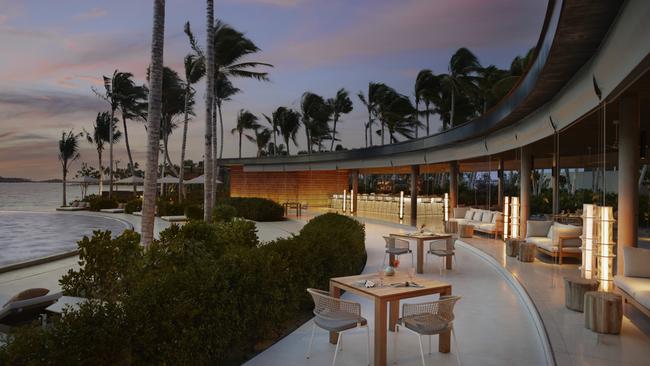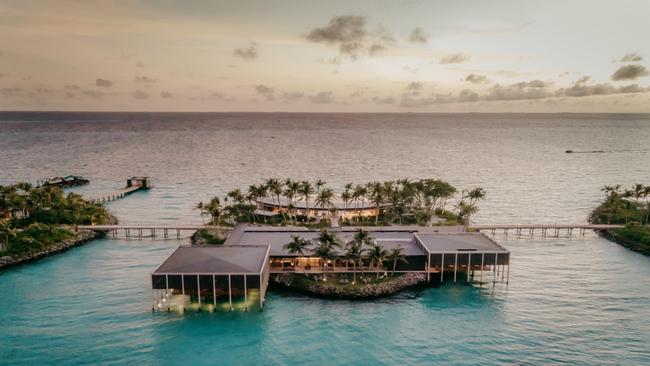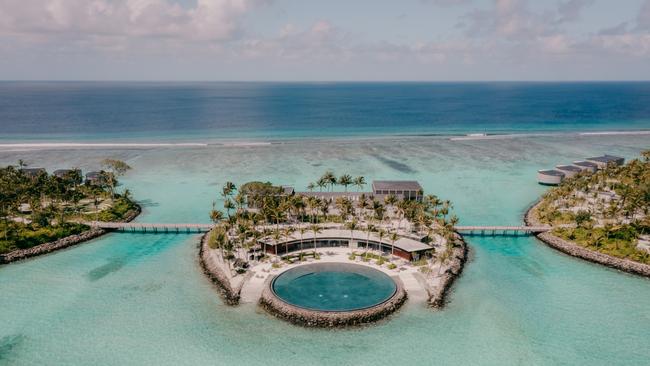Ritz-Carlton Fari Islands: is this the future of sustainable island tourism?
With a vision for sustainability, Ritz-Carlton Fari Islands aims to be a game-changer in the Maldives. But that doesn’t mean they’ve skimped on the wow moments.

Eighty-three years old, wearing a beatific smile, Jean-Michel Cousteau is just back from his second snorkel of the day. He’s still in his swimmers (for that matter, so am I). The son of the late, venerated explorer Jacques has flown all the way from Southern California here to the Maldives to inaugurate the latest iteration of his Ambassadors of the Environment program, an outdoor-education initiative that, as the literature reads, “extracts and distils lessons from nature and culture, using them to explore alternatives for a sustainable future”. Through the program, Cousteau and his team have developed interactive curricula and adventures across the planet, for children and adults alike to learn about the health of marine environments around the world.
Since 2005, it’s operated an exclusive partnership with Ritz-Carlton hotels and resorts to create actual field sites for the programs, at locations ranging from Grand Cayman to Santa Barbara (where Cousteau lives much of the year) and where we’re currently chatting – the new Ritz-Carlton Fari Islands, in the northern reaches of the Male atoll, which opened last June. Cousteau speaks about the documentaries he made in the ’70s, plastic pollution, the alarming rate of world population growth. Mostly, though, he speaks about the degradation of the planet’s ecology, and its oceans in particular.

Here in the hyper-vulnerable Maldives, he notes, it manifests in particularly conspicuous ways. “You see it in the temperature of the water, the quality of the coral reefs. I just saw it. I’m very concerned about those.” A sombre pause. But then another smile, and a segue to a description of the hornbill and green turtles he’d swum with an hour before, in numbers greater than he expected to find. “It’s exciting, because this location – we can really use it as an example. We ourselves are learning a lot just being here. And then all that can be shared.”
Learning and sharing: in 2022, they are the cornerstones of right-minded travel. Particularly to places such as this Indian Ocean nation – a crucible of the contemporary travel conundrum, scattered across some 1190 islands above and below the Equator. Tourism accounts for almost 30 per cent of the Maldives’ GDP, and around 50,000 of its population of roughly 540,000 people are employed in the industry, supporting families that likely account for many times that number. But the high-profile, high-gloss escapist experience that’s the currency of this place sits increasingly uneasily alongside the environmental crisis the world faces. Food importation, waste management, and damage to the natural environment, not least of all in the form of the carbon output associated with the long-haul flight to get there (particularly in a premium class), are all issues that require consideration, and mitigation.

The good news: the best Maldivian resorts increasingly take integrating legitimate conservation programs and sustainability practices into their operations very seriously. Many now grow much of their own food, and rigorously quality-control the sustainable sourcing of what they don’t; they educate their staff and their staff’s families; they conscript marine biologists to survey, and endeavour to improve, the health of the immediate environment; they build on energy-conserving, light-footprint lines.
The Ritz-Carlton here is part of Fari Islands, a multi-use development that aspires to be among their number. A mini-atoll of four discrete islets, comprising about 88ha, it’s the first multi-resort development with a full-service marina, retail hub, restaurants and beach club that are open to guests from anywhere else in the Maldives that’s accessible by power boat or sea plane. And it’s home to the flagship Patina resort, a new hospitality brand owned by Pontiac Land Group, Fari Islands’ Singapore-based developers. The whole is being spearheaded by third-generation Pontiac Land scion Evan Kwee. With what will eventually be three separate resorts – along with the Ritz Carlton and Patina, the Capella Maldives (another brand Pontiac owns and Kwee oversees) is slated to open here in late 2023 – it’s the largest hospitality project Pontiac has ever undertaken; according to a Forbes Asia report, the first phase of development cost more than Pontiac’s total revenues in 2020.
It’s ambitious, and has a lot riding on it; of which facts Kwee, of course, is acutely aware. But an enormous amount of thought has gone into Fari Islands – starting with how they are meant to be used by those staying on them. Guests at all the resorts, as well as from anywhere else, are welcome at the marina complex; a motor boat runs between the resorts and the beach club, shops, burger truck, bakery and wine bar and dive centre from morning to late evening, so that Ritz-Carlton, and eventually, Capella guests can come over for an hour or a day (Patina is on the same island, so its guests can stroll, cycle or buggy over).
Patina Maldives is a singular place in a few ways – aesthetically and experientially a departure from any Maldivian norm. Kwee commissioned the Brazilian modernist Marcio Kogan to design the villas and their interiors, which are gorgeously wrought in richly hued coral stone and timber, and feel almost as much Ipanema as they do Indian Ocean, in a very good way. The signature rigour of his lines is softened with layered textiles: beautiful light linens, organic cottons, hand-woven throw rugs. Kogan, a cultural magpie, is inspired by everything from literature to cinema, but not by big development; this was his first hotel project, and the eloquence with which the villas are in dialogue with nature speaks to his innate talent for intimate, residential scale. The tropical-modernist house vibe prevails inside as well: floors of dark polished hardwood, rich timber chairs and sleek headboards, home-like configurations, low-slung everything.

At Patina, Kwee has also brought contemporary art to Fari Islands, and the Maldives, in headline-getting ways. He enlisted Singapore-based advisers The Artling to curate a collection of textiles, photography and installations, foremost among which is Amarta, a spectacular Skyspace installation in wood and concrete by James Turrell – the only one the artist has completed in the Indian Ocean. Across the island, guests encounter works in rooms and public spaces, and along the beaches; more recently, in March, some of them might have come across Daniel Arsham, the New York-based multimedia artist known for collaborations with Pharrell Williams and Dior’s Kim Jones, who hosted studio visits and a private supper as part of Patina’s inaugural artists residency program.
More subtle is the built-in nature of Patina’s sustainability bona fides. Here, too, Kwee brought something of a different perspective. “I don’t want to say we’re doing anything new; there are people who pioneered [sustainability] in the Maldives way before we were on the scene,” he says. “We’re developers, first and foremost. So I wanted to shift the whole paradigm, and look at sustainability from the construction and building perspective – how we could do things greener, smarter, better before we even started. A lot of waste can go into building a hotel; we tried to institute that change from that day-one stage. Reduce waste, reduce manpower.” He’s keen not to misrepresent or overstate. “It’s also important, I think, to say that Patina’s on a reclaimed island. The coral it sits on was already completely bleached. But we were really careful about how, and where, we reclaimed.”
Take the hundreds of palms across the island: the majority were being cleared to make way for industrial or agricultural space on other islands, and would have become waste. “We paid a lot of money to locate, purchase and transport these trees, root balls and all. It was expensive and laborious, but it was important to us.”
He also points out that all the villas at both the Ritz Carlton and Patina are prefabricated. “That fact resulted in about a 30 per cent reduction of the workers we’d have needed with conventional construction. It’s faster, it requires less labour, less heavy equipment, and that overall means we generated significantly less waste.”
There’s an understated spa with a collection of cube-like standalone suites and a deeply serene relaxation area that vaguely echoes Turrell’s Skyspace. And the food is very, very good. Counting what’s on offer at the marina, there are a full 10 venues, ranging from Tuk Tuk, the sweet pink-painted gelato truck, to an artisanal bakery, Farine, to Roots, where the entire menu is plant-based, and Helios – an open-air, sand-floored bit of heaven, nestled on its own beach on the far north corner of the island, from whose kitchen issues a parade of Greek sharing plates, one more delicious than the next.
Patina is contemporary, even youthful, but also completely grown up in its understatement, and in the thoughtfulness behind so many of its details. The Ritz-Carlton, one island to the south, manifests more of an overt glamour quotient (though it can still be called understated, relative to some of the comp set here). The round timber villas, each with a huge sliding glass wall giving onto a terrace with plunge pool, are a prefab design by Kerry Hill Architects, and are typically long on light natural woods (sustainably sourced) and pale stone floors. About half are spread along various stretches of sparkling white beach, and half are over water, strung along boardwalks over the lagoon at the island’s north tip. The Estate is a three-bedroom, 1486 sq m oasis with multiple outdoor dining sites and its own private swimming cove.

The spa is a wow moment even for the Maldives – a vast ring-shaped overwater complex clad in rich timber, with high-ceilinged, subtly lit treatment rooms and an array of therapies ranging from crystal healing to gel manicures. The restaurants are more conventional than those at Patina, but hit most of their marks. You can eat solidly good Italian at La Locanda, or an excellent and very creative teppanyaki supper at one of the eight or nine seats at Iwau; and for softshell crab tacos and buckets of chilled prawns there’s the Beach Shack, which is alfresco lunching stripped back to its best elements.
In its aggregate, the Ritz-Carlton is luxury of a conventional, but not at all disappointing, sort. But to get the comprehensive experience requires a visit to the dive centre, where staffers from Cousteau’s Ambassadors of the Environment will give you another perspective entirely: the one from the air. Officially, the Ocean Rangers’ “Ocean Drone X” experience is designed for kids, but when I visited it was all adults flocking around the handful of iPads broadcasting live drone footage of the reef system along the western edge of the atoll, from some 100m up – spotting an eagle ray here or a reef shark there, tracking a shoal of trevally, and mapping errant fishing nets stuck onto outcroppings for later removal.
The staffers pilot them, but guests can book a hands-on simulation tuition. They can pair the experience with a guided snorkel during the day (or, more intriguingly, at night), or a dive, or even a session in a small submersible, to observe and understand better how all the inhabitants of reef systems, from microscopic to megafauna – what the Ambassadors have dubbed the “Cities Under The Sea” – collectively work to rebuild and regenerate. It’s sharing and teaching, and hopefully, in however small or large a way, layering a bit of Cousteau’s legacy, and an abiding appreciation of the fragile beauty of the place, into memory.

To join the conversation, please log in. Don't have an account? Register
Join the conversation, you are commenting as Logout